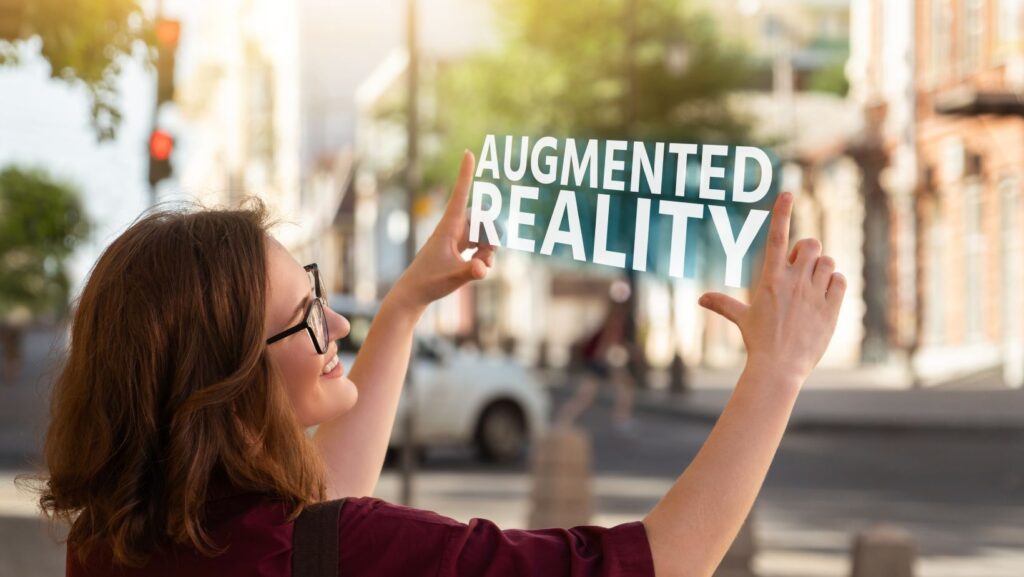In the realm of technology, Augmented Reality (AR) has emerged as a game-changer, transforming the way we interact with the digital world. It’s not just a buzzword; it’s a revolutionary tool that’s reshaping industries, from gaming to healthcare, education to retail.
AR’s magic lies in its ability to overlay digital information onto our physical surroundings, creating a bridge between the virtual and the real world. But how exactly does it work? And what potential does it hold for the future? Let’s dive into the fascinating world of Augmented Reality, exploring its ins and outs, its applications, and its untapped potential.
Understanding Augmented Reality (AR)
Augmented Reality or AR, as engaging as it appears, remains a complex piece of modern technology. At its heart, AR involves the interweaving of real-world environments with computer-generated visuals or data. Software applications harness the camera capabilities of user devices, mainly smartphones, to capture live video feed. In real time, these applications superimpose digital models, animations, sounds, or interactive elements onto the video, creating the illusion of these virtual components existing within the actual environment.

Three main characteristics distinguish AR from other mixed reality technologies. Firstly, it combines the virtual and the real. Unlike virtual reality (VR), which creates an entirely computer-generated environment, AR overlays virtual components onto the user’s actual surroundings. Secondly, it enables users to interact in real-time. AR applications bring interactive digital elements onto the user’s physical space, allowing them to manipulate these components using gesture or touch-based controls. Such functionality provides an immersive and engaging user experience. Lastly, it’s accurate in 3D. AR applications position and align their virtual assets with the real-world setting, ensuring the digital components appear anchored to their physical counterparts.
Applications of Augmented Reality (AR)
From revolutionizing surgeries to assisting in product design, AR’s potential is vast and formidable. This section explores the applications of Augmented Reality in detail across different industries.

- Medicine: AR finds extensive adoption in medicine, improving surgical precision and doctor-patient interactions. Surgeons leverage AR to visualize the patient’s body in 3D during surgeries, enhancing surgical precision. Consultants employ AR to illustrate medical conditions to patients, fostering better patient understanding.
- Manufacturing: AR aids in product design and manufacturing processes. Designers incorporate AR to visualize product concepts, eliminating the need for physical models. AR also helps in identifying manufacturing flaws early, saving time and resources.
- Tourism: AR enhances the tourist experience by overlaying information about historical sites or directions to destinations. It broadens travelers’ appreciation of the locale, adding depth to the travel experience.
- Education: AR offers immersive educational experiences, transforming traditional methods of teaching. Students grasp complex principles better when visualized using AR. It also adds a fun and interactive element to learning.
- Retail: AR revolutionizes shopping experiences by enabling customers to see how a product might look in their environment before purchase. Furniture retailers, for example, use AR to allow customers to visualize how a piece of furniture would fit and look in their home.
- Gaming and Entertainment: AR brings games and entertainment to life by superimposing virtual characters and objects into the real world. This integrates the user into the game setting, radically enhancing the entertainment factor.
Despite being in a nascent stage, these applications underscore AR’s transformative power across sectors. Each application of AR intensifies user engagement, thereby broadening its adoption further. However, the full scope of AR’s capabilities extends far beyond these applications, heralding unprecedented advancements in the digital world.
Augmented Reality (AR) Vs Virtual Reality (VR)
Stepping into the world of advanced visual technologies, comparisons between Augmented Reality (AR) and Virtual Reality (VR) become a frequent discussion point. For starters, AR supplements real-world environments with virtual elements, targeting improvements in fields extending from medicine to gaming. VR, on the other hand, constructs completely immersive virtual environments, primarily offering immersive experiences in gaming, training, and therapy situations.

The primary differentiation lies in the integration of the user environment. AR adds virtual elements onto physical reality, offering a blended reality experience. Each sector merits this addition differently – for surgeons, that’s increasing precision; for gamers, it’s escalating levels of engagement. By harnessing sensors and displays, AR overlays additional information, virtual objects, or graphics into real-world views.
Asserting it succinctly, AR amplifies reality by adding layers of helpful or entertaining digital elements, whereas VR, in creating entirely artificial environments, offers a compelling and intense level of immersion. The utilisations, whilst varied, focus on their key capabilities: AR’s enhancement of reality and VR’s construction of a new one. Each has its own unique implications and usage, potentially conspiring to reshape different aspects of human interaction with technology. While AR integrates seamlessly into daily activities, VR offers augmented and stimulating experiences that promise escapism into constructed realities.
Pros and Cons of Augmented Reality (AR)
When evaluating the advantages and disadvantages of Augmented Reality, one sees that AR offers a slew of potential benefits. Industries often leverage these advantages for their pragmatic use.

Advantages
- Multidimensional Interactions: Augmented reality offers a multidimensional user experience, encouraging synergistic interaction between digital elements and the real-world environment.
- Real-time Data: Through its integrated sensors, it offers real-time data, enabling quick decision-making and fostering efficiency in fields such as healthcare, manufacturing, and military.
- User Engagement: By merging virtual and real components, AR enhances user engagement, proving advantageous in sectors like retail, education, and entertainment.
Nonetheless, despite its benefits, AR isn’t devoid of some considerable downsides.
- High Costs: The development and maintenance of AR applications can be expensive given the complexity of the technology and the need for sophisticated hardware and software.
- Dependency on Technology: As it relies heavily on technology like sensors, cameras, and screens, any malfunction can negatively impact the AR experience.
- Limited User Accessibility: While the use of AR is increasing, it remains limited due to the need for specific devices, apps, or browser support to access AR content.
Future of Augmented Reality (AR)
As Augmented Reality (AR) continues to evolve, it brings forth new opportunities and potential impacts in several sectors. The future of AR is a promising vista, filled with ideas that could revolutionize everyday experiences.
Integration with Internet of Things (IoT) presents one avenue for AR expansion. AR devices, when connected to IoT-enabled devices, provide real-time data overlays to users, enhancing their interaction with their surroundings—for instance, smart glasses displaying thermostat readings directly onto a user’s field of vision.
Another significant development is the proliferation of AR in mobile applications. According to Statista, mobile AR active users are projected to reach 2.5 billion by 2023. Such apps, like IKEA’s furniture placement app, allow users to visualize items in their own homes before purchasing, bridging the gap between online and in-store experiences.

AR is also expected to advance healthcare. Researchers at the Imperial College London, for instance, are developing AR-assisted surgeries. Surgeons view patient scans overlaid with real-time videos, providing precision and reducing invasive procedures.
Education is another arena set to gain from AR. Oxford University reports that AR aids enhanced learning and engagement, offering 3D models for intricate concepts like human anatomy or particle physics, fostering comprehensive understanding.
Balancing the potential of AR with its challenges requires robust regulation and thoughtful implementation. The exponential growth in AR technology, nevertheless, hints at a future where virtual and real-world experiences are seamlessly blended, opening the door to a myriad of possibilities. As AR transcends novelty status, it’s carving out a new norm in technology utilisation, embedding itself into many aspects of life and work.
AR is set to Revolutionize
There’s no denying that AR is set to revolutionize how we interact with the world around us. It’s not just a game-changer for industries like healthcare and education, but it’s also poised to redefine social interactions and mobile applications. But as we embrace this transformative technology, we mustn’t overlook its potential pitfalls. Privacy concerns and cybersecurity threats are real and must be addressed head-on. The future of AR is bright and full of potential, but it’s crucial to navigate this new terrain with caution. Regulations need to keep pace with advancements, ensuring a balance between innovation and safety. As AR becomes an integral part of our daily lives, it’s not just about harnessing its power—it’s also about managing its challenges effectively.

